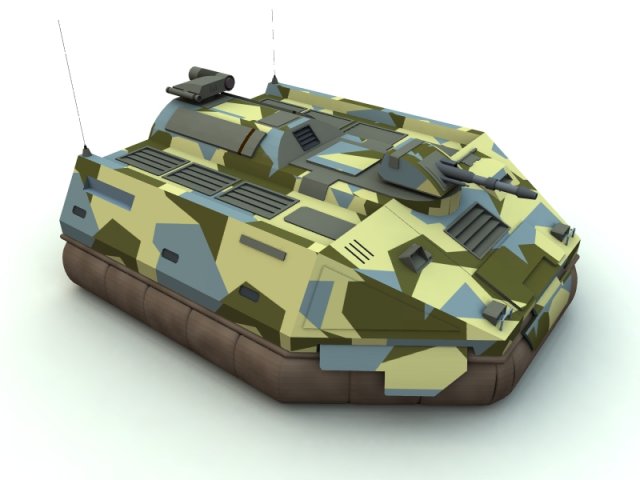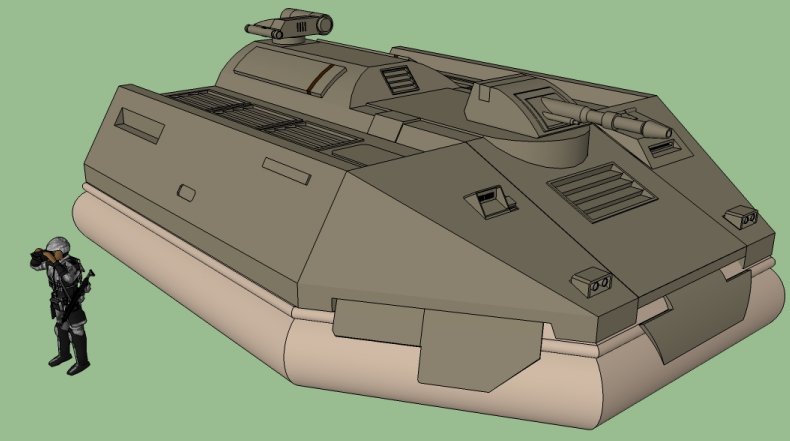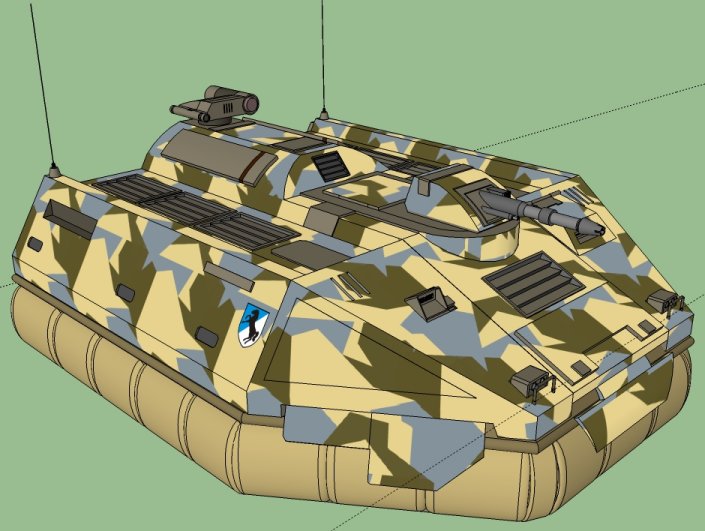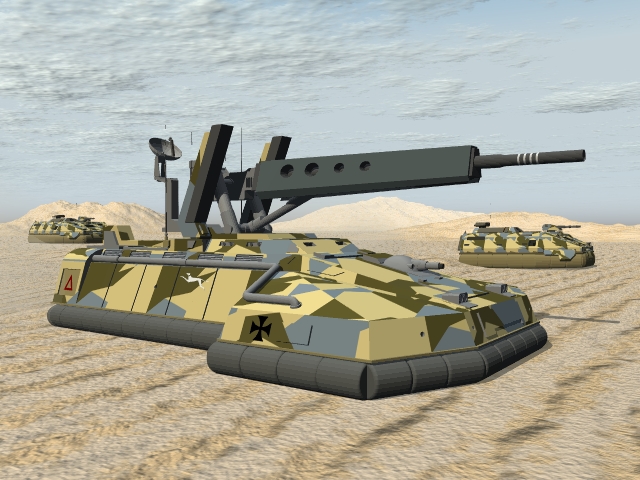
Luftkissengefectspanzertrager-XIII
Hover Assault
Carrier

|
Introduction
The Luftkissengefectspanzertrager-XIII
(LkGfPzTr-XIII), sometimes shortened to Gefectspanzertrager-XIII or just ‘Gefects-dreizehn’,
is Germany’s frontline assault hover APC utilised in conjunction with the well
known sturmtaktik. Developed from the standard APC version known as
LkPzTr-VIII, the Gefects 13 is designed to operate in close combat on top of
enemy positions and survive against most standard weapons. Alongside the
LkPz-IX hovertank it is one of the iconic vehicles of the new Bundeswehr. Narrative
Gustav Solms roared in
pain and frustration as a hidden Kafer blasted his battlesuit with pellets from
a gigantic shotgun, staggering him from his feet and forcing him to drop his
SK-19. He groped for the 11mm Stracher he carried on his left thigh and yanked
it from the holster while he rolled for cover, ungainly in the heavy armour.
Joseph strode past him, hosing streams of rounds from the MG-91 into the
recesses of the tools sheds that were the heart of the Kafer defence in this
sector. Then Joseph was down, a direct hit from a plasma shot drilling him
through the heart. Gustav swore again, came
up to a knee and started firing steadily using thermal images to aim the big
handgun. This mission was going bad quickly, this mining complex was being held
by the cut off survivors of two regular Panzer Grenadier companies who were
surrounded by Kafers. Gustav’s company of the division’s crack assault unit, LkGfPzGren.Abt.4,
were part of the rescue team. Only sturmtakik
works best
on Kafers when they are unaware and surprised, these aliens had been fighting
and seemed to be only warming up. The first wave of assault troops were getting
badly cut up. Then the second wave was
there, a Gefects 13 ramming through a barricade and sending Kafer soldiers
cartwheeling through the air. Seconds later its remote turrets were firing
again and heavily armoured soldiers were rising in its wake already firing. It
was joined seconds later by another two vehicles, one of them trailing thick
smoke from its turbines, which also added their troops to the fight. Gustav staggered to where
Joseph’s body lay, sprawled face first on the ground, scooped up the MG-91 and
got it firing again. Behind him the squad rallied as another carrier arrived
with more troops. It was vital that they made this break in and the link up
with the Panzer Grenadiers, they were running out of ammunition and they weren't
going to leave anyone behind alive for the aliens.
Colour Plates
The LkGfPzTr-XIII
was developed as a result of Bavarian experience in the Central Asian War where
the difficulties of breaching the heavy Manchurian anti-tank belts became a
significant tactical problem for all forces involved. However for the
relatively lightly equipped Bavarians it was a problem for which they devised a
tactical solution involving a mixture of infiltration and assault which would
become known as sturmtaktik.
The
Bavarians used the stalwart LkPzTr-V during the Central Asian War, and while
appreciating its many qualities it was not ideal for the tactics they were
using being a vehicle with limited internal volume. At the conclusion of the war
Bavaria acquired a number of Brandenburg produced LkPzTr-VII for trials
purposes. The LkPzTr-VII was a roomy vehicle designed for use by the
Brandenburg marines on the Baltic but which had a number of significant
tactical limitations with a limited armament.
In the
final years of the CAW Bavaria began the development of a new HAPC. This would
be a complete break with the legacy of the LkPzTr-V, being designed completely
from the ground up. The new design was significantly larger than its
predecessor and incorporated new armour and vectronics. Its armament would also
be upgraded with a powerful plasma weapon and coaxial machine gun in a remote
turret. The first prototypes were produced just prior to the War of German
Reunification and several were assigned to an experimental sturmtaktik unit.
These few prototypes saw action during the war in the German breakthrough on
the northern front, and performed very well.
After the
Reunification War permission was sought and received for the permanent
modification of the LkPzTr-VIII for a sturmtaktik specific vehicle to be
known as the LkGfPzTr-XIII. This vehicle featured enhanced frontal armour
protection, a second remote turret and drop hatches in the floor of the
vehicle. These drop hatches would allow battlesuit equipped infantry to drop
down into the plenum and then be subsequently uncovered as the vehicle moves
on. This deployment method allows for the troops to be in action faster than a
conventional dismount through a door. The second, rear mounted turret has an
automatic grenade launcher for increased suppressive firepower and a ATGW
missile launcher to engage heavy targets.
Production
of the LkGfPzTr-XIII commenced in 2304 with the first models being sent to the
divisional assault battalions within the frontline Panzer Grenadier Divisions.
The vehicle proved highly popular with the crews being both highly capable and
very comfortable. The vehicle was soon upgraded to the Aufs B version with
additional armour in the front arcs of the vehicle to enhance survivability.
Export sales were limited with the British buying 20 for trials purposes and
the Azanians purchasing several for their regular Mechanised Divisions.
The
LkGfPzTr-XIII first saw action against the Kafers in 2301 on Beta Canum with
the divisional assault battalion of 8 Luftkissenpanzergrenadier Division ‘Windhund’.
This unit fought all the way through the occupation and liberations of Beta
Canum. Further sturmtaktik units were part of the wave of German
reinforcements that came onto the French Arm in the wake of the Battle of
Beowulf. LkGfPzTr-XIII Aufs B
Type: Hover Assault Carrier
Crew: Driver, gunner, commander
Weight 5000 kg
Armor: Plenum: 2 Sides, Top: 30 Front: 60
Armament: Jaschonek Fabricant A-7 vehicle
plasma gun in a front-mounted remote turret Aimed Fire Range. 1600 m Range
Finder. + 1 ROF: 5 Rounds Carried: 30 DP: As tamped explosion (EP = 15) and a
coaxial 7.5mm MG91 machinegun in a frontmounted remote turret; and rear-mounted
remote turret containing a GW-120
30mm AGL
and a single Luchs missile
Signature: 5
Evasion: 6
Sensor
Range: 10 km
Range
Finder Bonus: +1
Cargo: 11 passengers and 400 kg
Max
Speed: 200 kph
Cruising
Speed: 180 kph
Combat
Movement: 420 m
Off-Road
Mobility: Full
Power
Plant: 1 MW
hydrogen fuel cell
Fuel
Capacity. 264 kg
Fuel
Consumption: 22 kg/hr
Endurance: 12 hr Price. Average price for the reconditioned Kangaroo-IV is Lv 285 000.
As described above the LkPzTr-VIII was
developed after the Central Asian War and came into full service in the wake of
the successful war with France. The vehicle is externally almost identical to
the LkGfPzTr-XIII and can be easily mistaken for it. The early models mounted
only the single front turret and lacked the deployment hatches in the floor of
the vehicle. The Aufs B, introduced in 2300, is equipped with the rear turret
from the LkGfPzTr-XIII increasing the vehicle’s combat power. The LkPzTr-VIII equips the mechanised infantry
units of the most of the frontline units of the Bundeswehr, which are also
equipped with the LkPz-IX. The combination of these two vehicles has performed
very well in units that have been engaged in the Kafer War on the French Arm.
There are only a few variants of the
LkPzTr-VIII due to the large numbers of still capable LkPzTr-Vs in the German
inventory which have been modified to fill support roles. The main variant in
service is the command version of which there is normally one in each company
to provide its main headquarters function. The size of the LkPzTr-VIII Befehls
makes it a very popular command vehicle. LkPzTr-VIII Aufs A
Type: Hover APC
Crew: Driver, gunner, commander
Weight 5000 kg
Armor: Plenum: 2 All faces: 20
Armament: Jaschonek Fabricant A-7 vehicle
plasma gun in a front-mounted remote turret Aimed Fire Range. 1600 m Range
Finder. + 1 ROF: 5 Rounds Carried: 30 DP: As tamped explosion (EP = 15) and a
coaxial 7.5mm MG91 machinegun in a frontmounted remote turret.
Signature: 5
Evasion: 6
Sensor
Range: 10 km
Range
Finder Bonus: +1
Cargo: 11 passengers and 400 kg
Max
Speed: 200 kph
Cruising
Speed: 180 kph
Combat
Movement: 420 m
Off-Road
Mobility: Full
Power
Plant: 1 MW
hydrogen fuel cell
Fuel
Capacity. 264 kg
Fuel
Consumption: 22 kg/hr
Endurance: 12 hr
Price. Average price for the
reconditioned Kangaroo-IV is Lv 154 000.
<TBC>
|

|
Jaschonek Fabricant A-7 The
A-7 is a
Central Asian War era rapid fire plasma cannon similar to the French CPL-1A. It
is designed for light anti-vehicle action and engagement of infantry strong
points. First introduced on later models of the LkPzTr-V it was integrated onto
the LkPzTr-VIII as its main armament.
Type: 160 MW Plasma Cannon Fire Control: +1 MG91 Machine Gun The MG91 is the standard
German medium machine gun. It is used by both infantry and as a coaxial or
pintle mounted weapon on a range of vehicles. Type: 7.5mm conventional machinegun
County: Germany Weight (empty): 7 kg Length: 110 cm Action: Single shot or bursts Ammunition: 7.5 x35mm fixed cartridge ball
Muzzle velocity: 960 mps Magazine: 150-round disposable cassette Magazine weight. 2 kg ROF: 5 Aimed Fire Range: 800 m (1000m on mount) Area Fire Burst: 20 (AFV=2) Area Fire Range: 600 m (780 meters on mount)
DP Value: 0.7 Price: Lv880 GW-120 Automatic Grenade
Launcher The GW-120 is the
standard German AGL. It can be used vehicle mounted or dismounted on a tripod.
Type: 30mm vehicle
mounted automatic grenade launcher Ammunition. Any 30mm
propelled grenade Magazine: 2 x 40-round
internal hoppers (gunner can select from either magazine at will) ROF: 4
Aimed Fire Range: 500 m
DP Value: Dependent on
grenade used. Luchs Aufs D The Luchs is the standard German ATGW. The Aufs D
is a single shot weapon designed for installation on lightweight vehicles. It
is much lighter than the other versions of the missile as it lacks the automatic
reloader. The weapon must be reloaded manually from outside the armour. On the
LkGfPzTr-XIII the Luchs is used to engage targets that might be found in depth
beyond the main objective and for staving off counter attacks until supporting
vehicles can arrive. Type: vehicle-mounted anti-vehicle missile
Nation: Germany Launcher Weight: 10 kg Missile Weight: 18 kg Range: 7,000 meters Guidance: automatic Homing Value: 17 Attack Angle: selectable Damage: EP = 40 Launcher Price: Lv3,000 Missile Price: Lv5,000 <TBC>
LkGfPzTr-XIII Aufs A, Luftkissengefectspanzergrenadier
Abteilung 8,
Deutsches
Kontinent Korps Jurgenburg, German
Continent, Beta Canum 4, 2nd March 2302 This plate shows a Gefects 13 of LkGfPzGren.Abt.8 in action against the
Kafers on Beta Canum early in 2302. As the divisional assault battalion this
unit was heavily involved in action against the Kafers attacking the German
colony, usually in the reserve role. This unit was most often committed to
counter attacks to stabilise the front but sometime was called upon to fight in
rear guard actions or in defence. The unit suffered heavy casualties but
evacuated to New Africa to continue to fight until the final liberation. This vehicle is in the standard German grey colours. It carries standard tactical markings, a German flag and the greyhound insignia of the division.
<TBC> LkGfPzTr-XIII Aufs B, Luftkissengefectspanzergrenadier
Abteilung 4,
X
Korps Hexenkessel, Dunkelhim, 24th
December 2302 This plate shows a LkGfPzTr-XIII of LkGfPzGren.Abt.4 in action during the
liberation of Dunkelheim. This unit deployed to the French Arm as part of the
liberation effort, initially stationed at Beowulf before fighting on Beta
Canum-4. The unit was heavily engaged on Dunkelheim in three major set piece
actions. This vehicle is painted in the unique pattern devised for the liberation of Dunkelheim.
<TBC> Saxon, 2nd Battalion, The Royal Regiment of Fusiliers, 8th Armoured Brigade, 3rd Armoured
Division, British Army Salisbury Plain, United
Kingdom, 11th July 2295 The British acquired some 20 LkGfPzTr-XIIIs under the designation ‘Saxon’
for a series of trials into the application of sturmtaktik in British
Army units. The unit chosen for this was Zulu Company of 2RRF which ran six
months of trials on Salisbury Plains in 2295. The experiment was not seen as an
overwhelming success as a control company using conventional tactics achieved
similar results when properly supported. The British chose not to adopt sturmtaktik
or the Saxon, the Saxons were instead retained for OPFOR purposes and still
serve in this role. This Saxon is shown in standard UK green camouflage, although today they are believed to be in a two tone green and tan pattern. The vehicle carries the Union Flag and the red fox emblem of the 8th Armoured Brigade. It carries the colours of the regiment from an antenna and the battle honour Imjin.
<TBC> LkPzTr-VIII Aufs A, Luftkissenpanzer Abteilung 91, 6 LkPz Div, I
Korps Heidelburg, Germany, 9th March
2299 This plate shows a LkPzTr-VIII of LkPz.Abt.91 on exercise in western
Germany in 2293. The battalion is part of I Korps which provides the high
readiness component of German defences against the French. The vehicle uses the standard German grey camouflage pattern.
|

Above: A LkPzTr-VIII Aufs B temporarily assigned to Freihafen's PKR11 unit during the liberation of Dunkelheim.
|
The original GfPzTr-XIII is described in the Ground Vehicle Guide by GDW. Modifications here include increased armour values, a change to the missile launcher and an increase in rate of fire for the GW-120. Description of sturmtaktik is taken from the article by D Hebditch on Etranger. Illustrations are by Ian Stead.
Copyright 2010, Ian Stead and D Hebditch. 13 Feb 10
|
